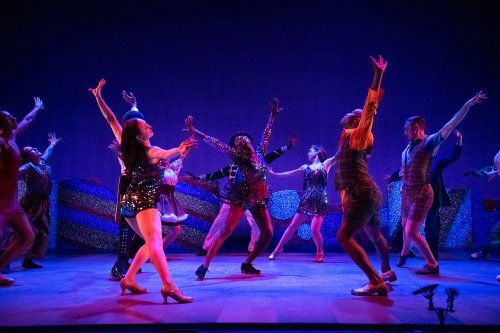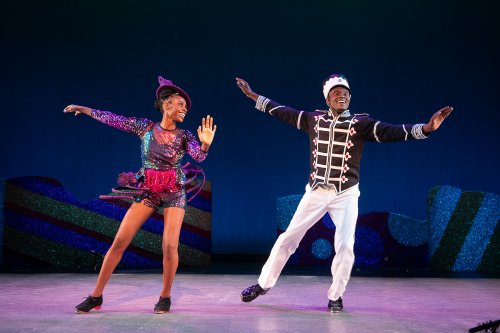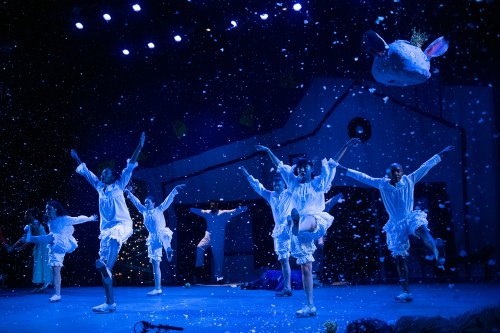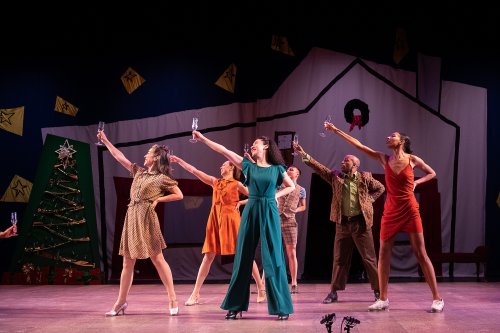Dorrance Dance: The Nutcracker Suite
World premiere of an entertaining, high-spirited, jazz and tap-dancing version of "The Nutcracker" is fun for the whole family.

Josette Wiggan-Freund (center) and company in a scene from Dorrance Dance’s “The Nutcraker Suite” (Photo credit: Christopher Duggan)
[avatar user=”Sheila Kogan” size=”96″ align=”left”] Sheila Kogan[/avatar]
T’is the season when audiences all over the country flock to see The Nutcracker. The popular, perennial favorite is such a staple that every sort of style has arisen to tell the story in its way. The latest is a tap dance version created by Dorrance Dance.
Performed at The Joyce Theater, Michelle Dorrance and her collaborators, Hannah Heller and Josette Wiggan-Freund presented this particular view of the beloved classic, using the vernacular of tap dancing. Skipping bits of the story, the length was too short for an entire evening, so this world premiere was presented second, following the intermission.
The music included the catchy, familiar tunes of The Nutcracker Suite by Peter Ilyich Tchaikovsky, first featured in classical ballet. The Dorrance version uses the absolutely wonderful jazz arrangement by Duke Ellington and Billy Strayhorn. No doubt the music would have been enhanced with a live orchestra, but one assumes that there was neither the budget nor the space for a Big Band orchestra. Nonetheless, the music is a marvelous interpretation, providing the perfect accompaniment for tap dancing – and certainly worth hearing again on its own. On occasion, however, there is no music, just the rhythmic sounds of tap dancing providing its own accompaniment.
Like many classics, The Nutcracker is so solid that it can withstand all kinds of different telling. In this version, there are minor differences, like the Mouse King of some productions becomes a Rat King here, but they remain rodents; the Sugar Plum Fairy becomes the Sugar Rum Cherry; Clara’s Uncle Drosselmeyer becomes her Godfather. However, the plot is the same: Clara is at a family party celebrating Christmas when her Godfather Drosselymeyer, the odd guy with a cape and an eye patch, arrives mysteriously and gives her a nutcracker as a present. She falls asleep and dreams of joining the Nutcracker in fighting off the Rat King, then celebrates her brave victory by watching a series of entertainments.

Josette Wiggan-Freund and Joseph Wiggan in a scene from Dorrance Dance’s “The Nutcraker Suite” (Photo credit: Christopher Duggan)
The entertainments included the Floreadores (the dancing flowers), who dance to the familiar “Waltz of the Flowers,” and Mother Ginger who introduced a gaggle of Slavic dancers from under her huge skirts. Combined with the Slavic style, these dances included hip-hop and some tap-dancing gymnastics.
Generally, this Nutcracker was wonderful entertaining. The divertissements, or the variety of different dances, carried the show as much as any of the plot. No doubt it’s why all the different variants work well. And in this version, the tap dancers are top-level.
One of the many highlights was Josette Wiggan-Freund as the Sugar Rum Cherry along with her Cavalier, Joseph Wiggan, who is her real-life brother. Together, they filled the stage with their megawatt personalities and talent. What fun!
Also notable are the whimsical, over-the-top costumes, especially those of the flowers (Floreadores or Sugar Rum Blossoms), which are out-loud funny. Credit goes to Andrew Jordan for costume design.
The sets are a colorful addition to the production (designed by Carolyn Mraz), and the lighting by Kathy Kaufmann unobtrusively changes the mood when necessary.

Claudia Rahardjanoto, Asha Griffith, Elizabeth Burke, Leonardo Manzari, Luke Hickey, Naomi Funaki, and Byron Tittle in a scene from Dorrance Dance’s “The Nutcraker Suite” (Photo credit: Christopher Duggan)
In this production, Clara is played by a cross-dressing fellow (Leonardo Sandoval). Although the Dorrance Dance group, who tends to consult with one another to create all of Dorrance’s productions, may have wanted to make a worthy statement about gender equality, but by using a grown man as Clara, the choice seemed to be off point, calling attention to itself, and changing an essential quality. It was, perhaps, less that he was male, but that he was clearly grown up and muscular. Isn’t the point of cross-gender casting that either should convey the story equally well? In this case, it appears that the character lacked the sense of vulnerability that should be essential to this story of a child. The other examples of cross-gender casting, like the Nutcracker (Brittany DeStefano) and the Rat King (Hannah Heller), were almost unnoticeable and so didn’t raise any issue.
But that quibble didn’t mar the overall enjoyment because the sense of high spirits carried this show from the beginning to the end. It is truly a production that the whole family can enjoy.
First on Program A, before the intermission, Dorrance Dance presented All Good Things Come to an End, which had its premiere in 2018. Like their other presentations, this was conceived, directed, choreographed, and performed by committee, specifically by Michelle Dorrance, Hannah Heller, Melinda Sullivan, and Josette Wiggan-Freund.

Carson Murphy, Maddie Murphy, Claudia Rahardjanoto, Luke Hickey, Matthew “Megawatt” West, and Asha Griffith in a scene from Dorrance Dance’s “The Nutcraker Suite” (Photo credit: Christopher Duggan)
They danced to the music of Fats Waller and Artie Shaw, a perfect partner for tap dancing. The women danced with fervor, good humor, a great deal of stage presence, and a sense of each other. In fact, they danced sometimes as if they were one person. Their synchronicity was amazing. Whenever they moved suddenly in a different direction or made an unexpected gesture, it was a surprise or even a delight.
There was an intellectual basis for this piece that had to do with the importance of saving myths and great pieces of literature once everything is burned down. Heavy, right? However, there was a big laugh when the audience understood one visual joke, the relationship between the story of Cane and Abel and the canes used as props, the kind used by Fred Astaire, for instance, in his stylish tap dances.
It seemed less important that the meaning or concept supported the overall production because the dancing worked so satisfyingly on its own merits as abstract pieces or simply entertaining ones. Sometimes the concepts seemed like intellectualizing, working too hard, or, at worse, not completely relative to the action. But the individual sequences are delicious and the dancers are enormously fun to watch, and listening to the rhythms of the taps is a deep pleasure by itself. So, what else could an audience want? You still have time to get to the Joyce Theater to see the company, which is recommended.
Dorrance Dance: The Nutcracker Suite (through January 5, 2020)
(Note: Programs A, B and C all include The Nutcracker Suite)
The Joyce Theater, 175 Eighth Avenue at 19th Street, in Manhattan
For tickets, call 212-242-0800 or visit http://www.joyce.org
Running time: one hour and 45 minutes including one intermission






Leave a comment